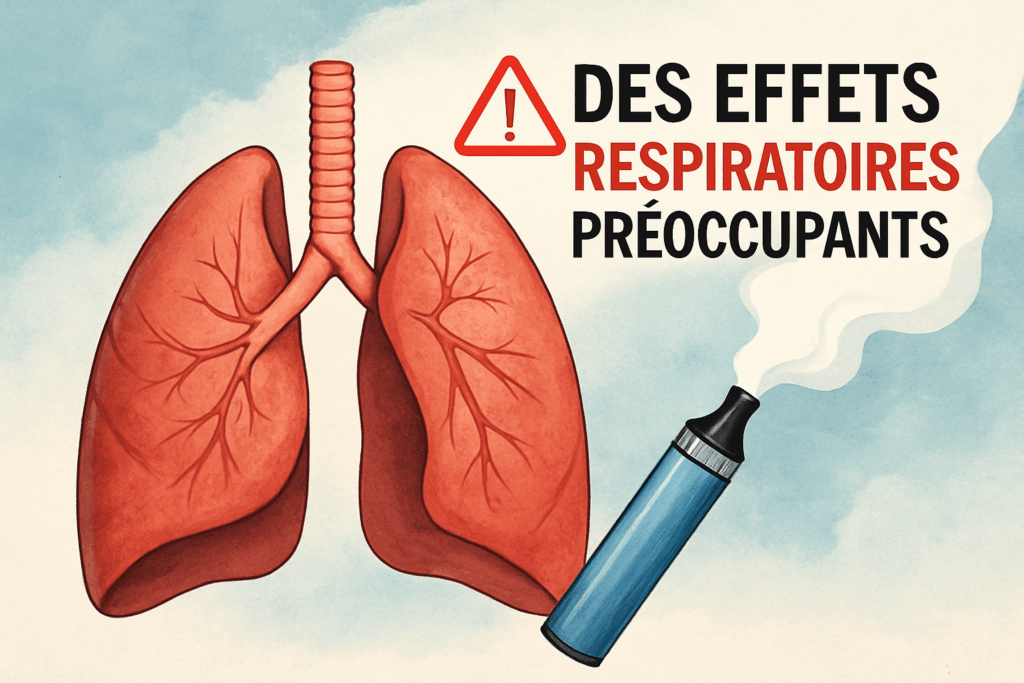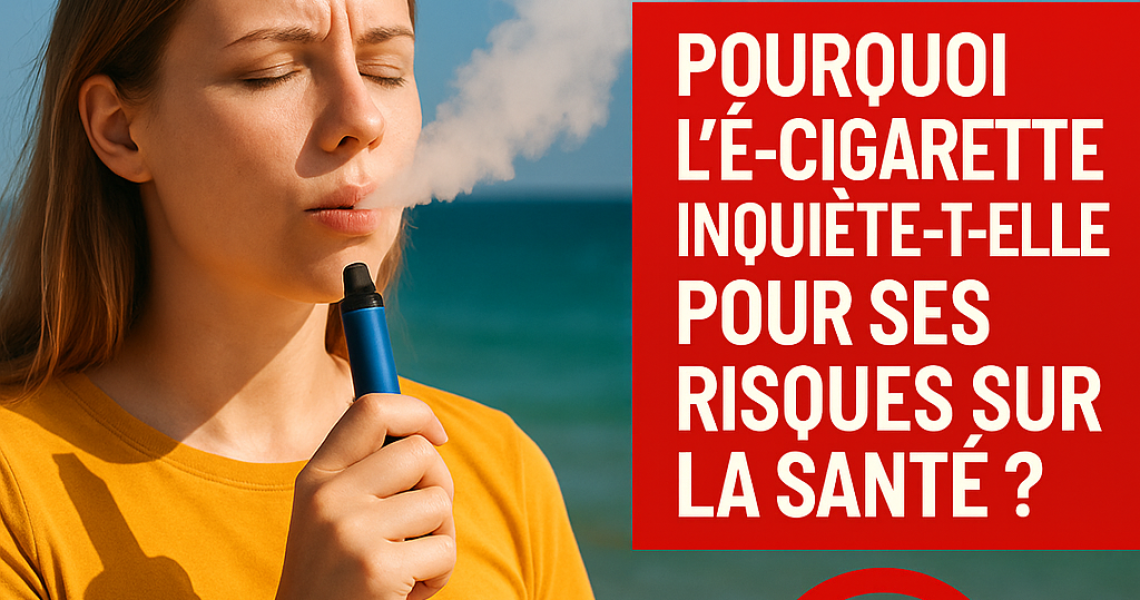
💨 An alternative to tobacco… not so harmless?
For years, the electronic cigarette has been presented as a “revolution” for smokers. Less harmful than tobacco? Combustion-free? With fruity aromas? At first glance, everything seemed to point to e-cigarettes as the ideal tool for reducing the risks of smoking. And yet… 🧐
More and more health professionals are sounding the alarm: vaping is not harmless. Behind the modern, technological image lies a complex product which, when inhaled repeatedly, exposes the body to chemicals that are sometimes toxic, poorly understood or poorly regulated. 🔬
Contrary to popular belief, the absence of tobacco does not mean the absence of danger. Several studies have highlighted the formation of irritant or carcinogenic compounds when e-liquids are heated, particularly at high temperatures. Formaldehyde, for example, an agent classified as a probable carcinogen, can appear during “dry hit” (overheating of the resistor).
And what about the additives used in flavorings? Although they are authorized for use in foodstuffs, inhaling them is not without consequences. The notorious diacetyl, responsible for “bronchiolitis obliterans” (nicknamed “popcorn lung”), has been found in some flavored e-liquids. 😶🌫️
To put it plainly: e-cigarettes are neither harmless nor neutral, especially when they become a daily habit, sometimes more intense than cigarettes themselves. And while it represents a potential risk reduction for adult smokers in transition, it should never be used by non-smokers, let alone teenagers.
👉 The real danger? Believing it’s safe.
⚠️ Substances of concern in e-liquids
The e-liquids used in electronic cigarettes contain a variety of chemical compounds, some of which are cause for concern. For example, studies have detected the presence of diacetyl, a substance associated with serious lung disease, in several fruity flavors. In addition, carbonyl compounds such as formaldehyde can be formed when e-liquids are heated, especially at high temperatures.
🧠 Nicotine addiction is still with us
Electronic cigarettes are often referred to as a simple withdrawal tool. A palliative for getting rid of tobacco. But an essential question is often overlooked: what about nicotine? 🤔
Yes, the majority of e-liquids sold today still contain nicotine, in various forms: standard or nicotine salts, which are faster and more powerful to absorb. Result: the brain is still stimulated, the immediate pleasure is intact, and… the addiction continues.
➡️ The vapoteur may no longer smoke… but he’s still hooked.
This psychological and physical dependence, subtle but real, maintains an illusion of freedom. We think we’ve stopped, we say we’ve “weaned”, when in reality we’ve simply changed vehicles… keeping the same engine: nicotine.
Nicotine is a powerful psychoactive substance that acts on the central nervous system. It alters the heart rate, affects mood and generates a compulsive need that can last for years.
Worse still, some people go from light vaping to excessive consumption, because the gesture is more discreet, the aromas more pleasant, and the impression of danger lessened. You smoke in the morning, in the evening, in the car, in front of the TV, at work… in short, all the time. 🚬💨
🔄 The result: an even stronger addiction than with conventional cigarettes.
And this also applies to young people. Many teenagers who have never touched a cigarette in their lives start vaping e-liquids with high nicotine content, convinced that it’s safe. But the teenage brain is particularly susceptible to addiction. What starts out as a game can become an early and lasting addiction.

👶 A gateway to smoking for young people
The appeal of electronic cigarettes to teenagers is a major source of concern. The sweet, fruity flavors, combined with a perception that they are less dangerous, make these products particularly appealing to young people. Studies have shown that e-cigarette use among teenagers can increase the risk of transition to traditional smoking.
🫁 Worrying respiratory effects
Cases of vaping-associated lung disease have been reported, notably in the USA, where users have developed severe lung damage after using certain vaping products . Although these cases are often linked to products containing THC or specific additives, they highlight the potential risks to respiratory health.
🌍 Evolving regulations
In response to these concerns, international bodies such as the World Health Organization (WHO) are calling for stricter regulation of e-cigarettes. The WHO has described these products as “unquestionably harmful” and recommends limiting their promotion, particularly among young people.
💡 The anti-smoking laser: a natural and effective solution to free yourself from cigarette addiction
Faced with the dangers of tobacco and the limitations of electronic cigarettes, more and more people are turning to a gentle, natural alternative: anti-tobacco laser. This innovative method, based on auricular reflexology and inspired by the principles ofauriculotherapy, breaks nicotine dependency without pain, without medication, and without nicotine substitutes.
Unlike patches, gum or electronic cigarettes, soft laser treatment acts directly on the ear’s reflex points linked to the nervous system and addiction mechanisms. The result? From the very first session, the desire to smoke diminishes sharply, withdrawal symptoms are reduced, and the tension associated with craving gradually disappears. 🌿
✔️ This method is particularly appreciated for its rapid action, proven effectiveness and lack of side effects. It is equally suitable for occasional smokers, heavy smokers or people who vapotage and wish to quit nicotine completely.
At MyLaserTabacwe offer personalized support in our specialized centers. Each consultant benefits from a protocol tailored to his or her profile, with friendly care and post-session follow-up toensure successful smoking cessation. Our results show a high rate of satisfaction, with over 90% success rate for those motivated from the very first session.
By choosing laser weaning, you’re opting for a natural, chemical-free method that respects the body and is in line with a sustainable global health approach. Whether you’re looking for an effective solution to stop smoking, to put an end to tobacco dependency, or to free yourself from electronic cigarettes, anti-tobacco laser is a serious, modern and reassuring way forward. 🚭✨
✅ In conclusion: an addiction remains an addiction, whatever its packaging.
Despite its modern image and the fact that it’s less toxic than traditional tobacco, the electronic cigarette is not the miracle solution we’re led to believe. Behind the scented clouds and seductive designs, they often maintain nicotine dependency, prolong the smoker’s habit and can even become a gateway to more harmful behaviors, particularly among the young. 😶🌫️
If you’re here, it’s probably because you want to take back control, break the spiral and regain real freedom. The good news is that there’s now a natural way to do just that, without chemicals, substitutes or frustration: the anti-smoking laser.
Based on the principles of auricular reflexologyour gentle, targeted approach has an in-depth effect on the mechanisms of addiction. At MyLaserTabac, we help you to free yourself from cigarettes, e-cigarettes and nicotine addiction, with human, respectful and 100% individualized support. 🌿
Because it is possible to live tobacco-free.
And because the best time to start is now. 🚀
Make an appointment at one of our centers and give your body a new lease of life. Your health will thank you. 💛
